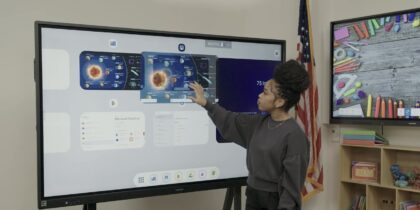Across the United States, students have started a new school year. While some are back in physical classrooms, about 50 million public school students are now learning remotely, using virtual classrooms and their home laptops, desktops or Chromebooks to connect to their school districts’ networks.
With students and teachers relying on video calls, desktop apps and other mobile services, many of them are having technical problems. Internet connectivity aside, apps may lag, images may glitch and software may take too long to open.
Unfortunately, these issues have big consequences for students. Frustration arises when they have to wait for their schoolwork to load, which slows down their learning process. A Pew Research study1 from April found that four out of five Americans believe K-12 schools have a responsibility to provide at least some of their students with computers or tablets to help them complete their schoolwork during COVID-19, and these issues fall squarely on the shoulders of schools’ IT teams.
There is a fix for some of these issues, though. School districts and their IT staffs can eliminate the problem of lag and app loading delays by purchasing solid state drives (SSDs) for student laptops and their classroom desktops.
Speed leads the way
The biggest benefit of SSDs is their speed. When a student opens a new app on their laptop, they often have to wait as a traditional hard drive starts spinning to access the app data. But with SSD drives, since the data is directly accessed by the controller, apps open almost immediately. It might not seem like a big deal, but SSD drives also use less battery power than traditional hard disk drives (HDDs), so students don’t have to stay tethered to their desk — and an outlet — all day. They can move wherever their learning process takes them.
Understanding SSD endurance and over-provisioning
Get your free guide to optimizing SSD over-provisioning for improved cell endurance. Download Now
SSDs’ agility and mobility also make them suitable for remote learning environments. With school environments still in flux and COVID-19 infection rates ebbing and flowing, schools that are open one day may close the next day for safety protocols. Students need the right tools in place to help them transition smoothly from the classroom to their home learning environment. SSDs can move between different learning environments so students always have their data and schoolwork with them, no matter where class is held.
Additionally, for school districts hamstrung by budgets, the implementation of solid state drives to upgrade current laptops or in-building computers is more cost efficient than flat out replacing technology stacks altogether. Upgrading those devices also saves time on the transferring of older technology to newer as well not having to lose time when teaching students and faculty how to use new equipment.
Rugged reliability
The very nature of remote learning — where devices are transported from classroom to car to bedroom to kitchen table — means that students’ mobile devices have to be reliable and rugged.
If a student’s device breaks while their school is shut down, they can’t learn until their school reopens. This is where SSDs shine.
SSDs have no moving parts. Unlike traditional HDDs, which have spinning disks and moving arms, SSDs are — as their name suggests — solid. There’s far less opportunity for any components to break, as the devices are more shock proof, run at cooler temperatures, and are more energy efficiency. A typical SSD failure results from an actual problem with the memory. What’s more, SSD drives are nearly immune to the bumps, drops and bangs that student devices so often incur.
Discover how to improve SSD memory performance with over-provisioning in this free white paper. And get tips on choosing the best Samsung tablet for your students.
1 Pew Research Center. “59% of U.S. parents with lower incomes say their child may face digital obstacles in schoolwork.” September 10, 2020








